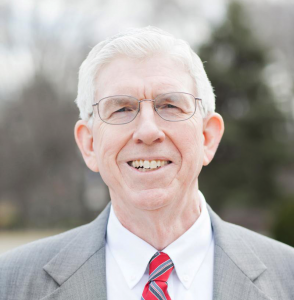This article is part 14 in a series by Tom Nettles on Remembering Jesus Christ. (Part 1, Part 2, Part 3, Part 4, Part 5, Part 6, Part 7, Part 8, Part 9, Part 10, Part 11, Part 12, Part 13).
A Summary of Chalcedon
Leo’s Tome led to Chalcedon’s clarity. This creed of 451 A. D. toes the line on the difficult idea of two natures maintaining absolute integrity with full manifestation of the distinct and incommunicable properties of each in one person. Also, for the first time in a creedal affirmation, we find the term theotokos—God-bearer, or mother of God. Often the term provokes an immediate negative reaction because of the self-evident truth that God is self-existent, without beginning, infinite in glory, power, and wisdom, dependent on nothing outside of himself for his purpose, his decrees, or his ability to perform all that he so desires. The implications of Scripture are clear when he declares, “Who hath directed the Spirit of the Lord, or being his counselor hath taught him? With whom took he counsel, and who instructed him, and taught him in the path of judgment, and taught him knowledge, and shewed to him the way of understanding?” (Isaiah 40:13, 14 KJV). Also one would pause before accepting such a doctrinally loaded word because of specific affirmations of Scripture concerning the Son: “For by him were all things created, that are in heaven and that are in earth, visible and invisible, whether they be thrones or dominions or principalities, or powers: all things were created by him and for him: And he is before all things, and by him all things consist” (Colossians 1:16, 17 KJV).
So how can such a being ever be thought of as having a mother? This is precisely why Paul wrote, “And without controversy great is the mystery of godliness: God was manifest in the flesh, justified in the Spirit, seen of angels, preached unto the Gentiles, believed on in the world, received up into glory” (1 Timothy 3:16 KJV). I accept the propriety of the word “God” because of the grammatical context. Paul wrote above about “the household of God . . . the church of the living God,” and begins the confession with the pronoun “hos,” translated “who” with “God” being the only antecedent.
This strange, but clearly revealed, truth of the birth of Christ, shows that the conception by the Holy Spirit of the child in Mary was the moment of the union of God the Son with true humanity in one person, that would be born, crucified, buried, risen, ascended, and would so come again in like manner. As discussed in a previous post on “Remember,” the mystery as announced to Mary (Luke 1:31-33) said that she would “bring forth a son” who would be given the “throne of his father David,” and that he should reign forever and “of his kingdom there shall be no end.” Though she knew not a man, this would happen because “the Holy Spirit shall come upon thee,” creating fertility in her egg without the corruption of a human father. At the same moment of such a conception, “the power of the Highest shall overshadow thee.” That means that the Father in his mysterious eternal activity of generating the Son caused a personal assumption of the human embryo by his Son with no lapse of time between the Spirit’s work of conception, the Father’s work of “overshadowing,” and the Son’s condescending to assume the human nature, taking the form of a servant, committed to conduct himself within the framework of humanity. That which was to be born of Mary would be called “the Son of God.” The singularity of this person so conceived, therefore, would be God in the flesh—“The word was made flesh and dwelt among us” (John 1:14).
This truth of the birth of Christ, shows that the conception by the Holy Spirit of the child in Mary was the moment of the union of God the Son with true humanity in one person.
This reality was revealed to Elizabeth, Mary’s cousin, so that when Mary traveled to stay with her for some months, Elizabeth greeted her with these words: “Blessed art thou among women, and blessed is the fruit of thy womb. And whence is this to me, that the mother of my Lord should come to me?” (Luke 1:42, 43). These words confirm the rather startling title given to Mary in this creed. They do point out that Mary, among all the women of the earth from the creation till the close of history was given this extraordinary blessing from God, (though she knew the truth of the words “a sword shall pierce through thy own soul also”), to be the one through whose seed the Messiah came. The real intent, however, of such a title, and such an observation from Elizabeth, was that this single child, this one person enfleshed the Creator and sustainer of all that has been made as the one who also would be mediator between God and man, the man Christ Jesus.
Efforts to avoid the apparent clumsiness of the term, “God-bearer,” leads to erroneous assertions. To say “Mother of Christ” or “Christ-bearer” in order to avoid using the word “God” does not escape the problem unless one is willing to assert that the Christ she bore was not God. If one seeks to avoid the hypostatic union of the two natures by saying the unity was only of sympathetic will, as the human person borne by Mary had established in his soul a complete union of purpose with the Son of God, then one is back to the error of adoptionism. The best option, given all the biblical data and the soteriological purpose of the incarnation, is to affirm the term, theotokos, for it captures all the power implicit in the Johannine assertion, “The Word was made flesh and dwelt among us” (John 1:14).
On the basis of Leo’s letter, therefore, the following paragraph was set forth by the council of Chalcedon as an explanation of the doctrine consistent with the Creed of Nicea.
We, then, following the holy Fathers, all with one consent, teach men to confess one and the same Son, our Lord Jesus Christ, the same perfect in Godhead and also perfect in manhood; truly God and truly man, of a reasonable soul and body; consubstantial with the Father according to the Godhead, and consubstantial with us according to the Manhood; in all things like unto us, without sin; begotten before all ages of the Father according to the Godhead, and in these latter days, for us and for our salvation, born of the Virgin Mary, the Mother of God, according to the Manhood; one and the same Christ, Son, Lord, Only-begotten, to be acknowledged in two natures, inconfusedly, unchangeably, indivisibly, inseparably; the distinction of natures being by no means taken away by the union, but rather the property of each nature being preserved, and concurring in one Person and one Subsistence, not parted or divided into two persons, but one and the same Son, and only begotten, God the Word, the Lord Jesus Christ, as the prophets from the beginning [have declared] concerning him, and the Lord Jesus Christ himself has taught us, and the Creed of the holy Fathers has handed down to us.[1]
When the council of Chalcedon met, a committee was appointed to finalize its statement of orthodoxy. The committee considered several documents that had been produced during the controversy between Cyril of Alexandria and Nestorius of Constantinople and the “Tome” of Leo concerning the position of Eutyches. This committee produced a document that succinctly and clearly stated the position of the council. Given the tensions present, and the fact that this is committee work, it is remarkable for its chaste conservatism, its doctrinal clarity, and its avoidance of metaphysical speculation. The pure “creedalism” of its assumptions, its anathemas, its pretensions to virtual canonical status would probably be resisted by the free-church, sola scriptura, orientation of Baptists and some others, but the careful expressions of the doctrine of Christ’s person should be joyfully embraced as a lucid, profound, and biblically accurate guide to both doctrine and interpretive principles.
Several items of theological and interpretive importance are distilled in this short statement. First, the creed seeks the consent of the reader that this formula is a true presentation of Old Testament prophecy, the teachings of Christ himself, the true doctrinal tradition of the church fathers, and the unalloyed meaning of the Nicene Creed.
Second, Jesus Christ really was God incarnate, the second person of the eternal Trinity. The eternal word that was with God (the Father) and was God (the Son) truly dwelt among men as a man. Jesus was not a mere phantom, nor a separately-personed man adopted or merely inhabited, but the one whose scars, whose hands and feet, were those of the one that was Lord and God (John 20:28).
Third, Jesus the Christ was truly and fully human. Not only was his body of the same stuff as our body, but he had all the soulish, rational, and spiritual aspects of humanity including human affections. His affections and perceptions constituted a soul that would be “exceedingly sorrowful, even unto death” (Matthew 26:38). He was of the same essence (“consubstantial”) as us but without the intrusive and corrupting factor of sin. Though people could clearly see that he was an extraordinary person (Matthew 16:13-16; Luke 7:14-17; John 3:2), none ever thought that he was less than a man.
The eternal word that was with God (the Father) and was God (the Son) truly dwelt among men as a man.
Fourth, without any mixture or confusion of the two natures that would compromise the integrity of either, Jesus was one person. All that he did as a person was an expression of the peculiar and distinguishing attributes of each nature. This perfect union in one person is emphasized by the vigorous expression of Mary as theotokos and the insistence that “the property of each nature” not only is preserved but concurs “in one Person.” All that he did as prophet, priest, and king was done in his capacity of Christ, so that each nature, concurring in the one person, contributed essentially to the proper fulfillment of each office. For example the First London Confession of the English Particular Baptists says, “That he might be such a Prophet as thereby to be every way complete, it was necessary that he should bee God, and withal also that he should be man; for unless he had been God, he could never have perfectly understood the will of God, neither had he been able to reveal it throughout all ages; and unless he had been man, he could not fitly have unfolded it in his own person to man.”[Lumpkin, 160]
Fifth, one must distinguish between nature and person. The personhood of Jesus was founded on the personhood of God the Son. The human nature was assumed by the Son of God but did not exist as a separate human person. That was the tendency of Nestorianism that fell short of the doctrine of the hypostatic union, that is, this one single person that was born of Mary from the moment of conception and every moment subsequent to his conception was both the eternal Son of God and the son of Mary, thus descended from David. This distinction between person and nature indicates that the properties of personhood are consistent, whether it be of God or man, while the natures are distinct. Though the personhood consisted of the personhood of God the Son, its properties were consistent with Jesus’ human nature expressing itself in a fully personal way, so that in his communications, friendship, and affections in his humanity, there was nothing that was impersonal.
Hallelujah, What a Savior!
Victories of the past do not suffice for the present. Champions of error will continually seek to reclaim ground that they lost. Those who cherish the advances of truth from the past must seek to establish a bond with the courage, strength, and clarity of yesterday’s captives of truth and uncorrupted worship. Each generation has an increasing burden as well as blessing of stewardship. Revelatory truths stated and defended through careful thinking, hard work, and wrenching conflict must not be lost. Contemporary challenges must be dismantled while the grounds of defense must be reclaimed. Implications for present issues and for further understanding of the richness of divine revelation becomes a part of the stewardship of those who desire to “continue in the faith firmly established and steadfast, and not moved away from the hope of the gospel” that they have heard, embraced, and found to be their very life.
[1] Philip Schaff, Creeds of Christendom, 2:62, 63.
This article is part 14 in a series by Tom Nettles on Remembering Jesus Christ.
Join us at the 2024 National Founders Conference on January 18-20 as we consider what it means to “Remember Jesus Christ” under the teaching of Tom Ascol, Joel Beeke, Costi Hinn, Phil Johnson, Conrad Mbewe and Travis Allen.
























